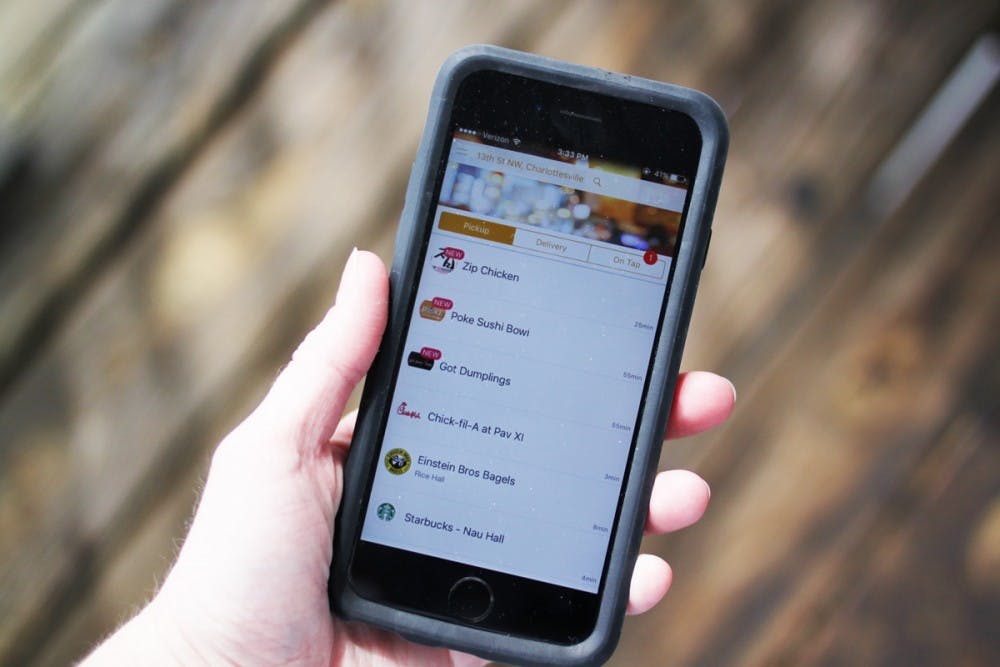Over the past few years, multiple food delivery service apps have started to pop up on Grounds and college campuses across the country. The growth in food delivery services reflects the overall growth in other services industries as people search for easier ways to get what they want, when they want it.
Tapingo, which first started at Santa Clara University in 2012, is an app designed specifically for college campuses with the understanding that students need accurate wait times and the ability to access their favorite shops immediately.
The Tapingo app enables students to order delivery options from local restaurants and, also, since it partners closely with dining services, students can use their meal plans or dining dollars. Today, it is available at over 200 campuses.
Hilary Kenyon, growth manager at Tapingo, said in an email to The Cavalier Daily that since its introduction to the University community, over 2,800 students have downloaded it to date.
“We have been excited and humbled by the overwhelming welcome from the U.Va. community,” Kenyon said. “Working with the dining staff and operators has been a true pleasure and we are so thrilled to see the program continue to grow campus-wide.”
Another app, JoyRun, which maintains its headquarters in Silicon Valley, has also been introduced on Grounds in the last year. Unlike Tapingo, it is a peer-to-peer food delivery service app. This means it allows users to see who wants food in their area, create or join existing requests for runs and then connects users with other app users to make deliveries.
Runners make money through delivery fees and tips when they make each individual run. This usually spans from $0 to $5 but averages around $2 to $3. Runners are also awarded points which hold monetary value for doing good things in the community. App users can also get a discount when they share their personal promotion code with other friends who sign up.
“We’re at over 50 campuses. We have dedicated leaders on each campus. They work on marketing initiatives — putting up fliers and different events. Their job is to let students know what the app can do for them,” said Amir Naveh, a marketing and PR representative for JoyRun.
Third-year College student Clay Grimes is one of these student leaders who works for JoyRun.
“You can request literally anything on the JoyRun app,” Grimes said. “So if you wanted Gatorade from CVS or if you have a dog and you need dog food, you can request that. If you’re feeling sick and you need motrin, you can request that from a pharmacy.”
There are no minimums that must be met in order to request a run, and food prices are similar to restaurant prices. After about two months of active marketing for the app, Grimes said just over 2,200 students are currently using the app.
“I actually get to know a lot of people who use the app regularly. So when I see them around Grounds, we’re really friendly and we’ll say hello,” Grimes said. “Since it’s mainly student based, it’s like we’re also forming this little community. It’s a really nice way for students to help other students.”
Grimes went on to say that he would like to see the app become a household name on Grounds, which may be tough since there are multiple food delivery service apps on Grounds, like Tapingo and OrderUp.
However, Assoc. Commerce Prof. Nicole Montgomery said she is unsure of the sustainability of individual food delivery service apps.
“There’s definitely a trend towards food delivery services, but people are increasingly deleting apps from their phones,” Montgomery said. “Actually, today, people only keep about 37 apps on their phones that they actively use. So, it’s unclear right now whether or not it will sustain multiple food apps.”
Montgomery said consumers are looking for apps which can be used to access multiple services.
“We’re starting to see an evolution where we have integration of multiple services into a single app or a single interface,” Montgomery said. “As an example, food delivery is now being integrated into Amazon Alexa so it’s not that I’m opening different apps, it’s that I’m communicating my preferences for different services via the same interface.”
Nevertheless, Montgomery said she did not want to say that food delivery service apps like JoyRun and Tapingo won’t be able to succeed.
“Food delivery services overall, I think we’re seeing growth in that space,” Montgomery said. “So, what that tells me is that there’s obviously a demand for additional food delivery services that may mean that multiple food delivery services could coexist on Grounds.”







